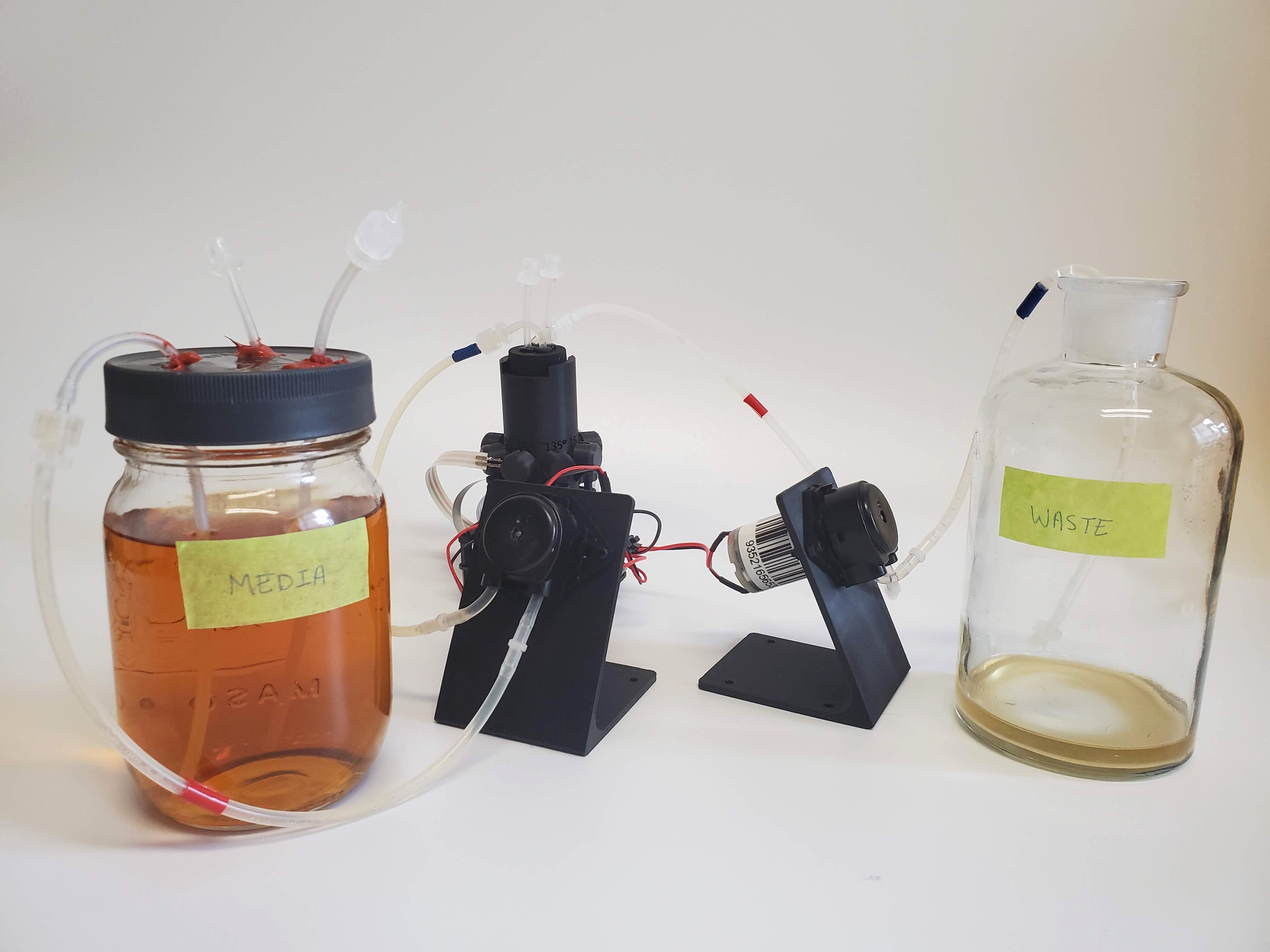Using custom automations to control your Pioreactor
Inspired by this paper by Knutson et al. (2018), we created a new temperature automation that cycles temperature as a sine wave between 30°C and 40°C over 24 hours. With this new automation, and in our expanded Pioreactor/turbidostat system, we grew some yeast over the weekend – and the findings are quite interesting!
How we expanded our Pioreactor

Figure 1: An image of our turbidostat setup.
We recently constructed a turbidostat system using pumps to remove waste and add media periodically. This system is powerful as it provides the yeast a rich environment to grow in, allowing us to measure the maximum specific growth rate of our culture over time. If you want to transform your own Pioreactor, or learn more about this bioreactor technique, check out our Experiments guide here.
Our Pioreactor checks the normalized OD (nOD) every minute, and doses the vial with 1mL of fresh media (and removes 1mL of waste) if the nOD surpasses our target OD of 2 AU. In doing so, we can keep our culture at a fixed “size” so our culture never gets overcrowded or depleted of nutrients. This allows the growth rate to be maximized, given that there’s no limiting nutrient factors and the yeast are growing faster than our dilution rate (to avoid being diluted out of the system).
Creating the new automation
We’ve made it accessible for you to make your own automations on Python so you can explore specific ideas, and/or change how you want a given automation to work. In our case, we added a new temperature automation, but you can design all sorts of automations to suit your interests.
This ability sets our bioreactor apart from all the others; we’re offering the flexibility to transform your Pioreactor however you see fit! There’s also an option to turn your code into a plugin so you can share your code with others, or download existing code from the community.

Figure 2: The Plugins page, where you can install additional functions created by you or the community.
Once we created our automation plugin and installed it from this plugins page, this new temperature option was available:

Figure 3: New option “Cycle Temp” in the temperature automation drop-down menu (left); Description of “Cycle Temp” automation once selected (right). Typically, only Silent and Stable automations are available.
With all that in place, we can begin theorizing and conducting our experiment.
What we know:
If we kept the temperature at an ideal 35°C, we expect a slow increase in maximum growth rate over time as seen in a previous experiment:

Figure 4: Growth rates of yeast in a turbidostat with constant temperature.
This is because faster growing yeast will eventually outcompete slower growing yeast in a constant environment. However, in nature, temperatures fluctuate over a day. We can replicate these more natural conditions using our new temperature automation!
From our previous temperature experiment we also know our yeast (S. cerevisiae) grows optimally around 35°C. Temperature effects are non-linear, so as it becomes too hot or cold, we can expect our yeast to slow down in growth rate.
So, let's see all this in action:

Figure 5: Two data sets (maximum growth rates and temperature) plotted over time.
The peak maximum growth rates occur when the ideal temperature of 35°C is reached. When temperatures become too hot or cold, we see a dip in maximum growth rates. Since all other factors in our turbidostat are the same, we conclude that these dips and peaks are a result of our oscillating temperature changes. Note that there's a slight lag in reaction between temperature changes and yeast growth.
Our experiment was run over 2-3 days, but this is a great example of an experiment that can take place over a prolonged period of time to study directed evolution in an organism. Perhaps over time, the yeast would acclimate to the oscillating temperatures and there would be less “lag” between the temperature and maximum growth rate changes. Or perhaps you'd see something entirely different! With the Pioreactors flexibility in automation customization, you can even explore different temperature scenarios – such as sudden spikes, varying ranges, or whatever you'd like. It's up to you to discover!
References
Knutson, C. M., McLaughlin, E. M., & Barney, B. M. (2018). Effect of temperature control on green algae grown under continuous culture. Algal research, 35, 301-308. https://doi.org/10.1016/j.algal.2018.08.020

